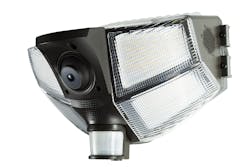The use of AI is growing in many industries despite media- and Internet-fueled panic that it is going to "take over" or eliminate human jobs. Despite the mixed publicity, there are already a myriad of practical uses--including theft prevention.
"AI needs to be captive to applications and controlled by people with boundaries on it, so it can solve problems," says Greg Ayres, VP of marketing and business development for iDter, a company that blends AI with live camera feeds for automated detection and what it calls immediate deterrence.
The iDter Nio Guardian system sees threats, decides the threat level, and can mete out responses. "Our use [of AI] is very structured and contained," Ayres says. "We use it to solve a problem. People can't access our AI and do something else with it."
Equipment theft, along with vandalism, stolen parts--and even stolen fuel--are on the rise, and the stakes are higher in the current business environment, with high prices, and equipment availability and supply chain issues. Assets are more valuable than ever.
"Construction sites face the ever-present risk of stolen equipment and tools, building supplies, and commodity materials like copper wiring, and also loitering and vandalism," Ayres says. "Even if the equipment and materials are secured inside a building, there is still a risk of forced entry. Without proper site surveillance, monetary losses can be considerable and likely be compounded by unnecessary delays to the project.
"The largest areas of growth for our system are the protection of open-air equipment; truck, tractor and auto dealerships; construction sites; and vehicle repair facilities," Ayres says.
Indeed, the National Equipment Register reports in its annual 4th of July Heavy Equipment Theft Trends that dealerships, work sites, and storage areas are the top three targeted locations for thieves. The favorite equipment categories are utility vehicles, mowers, and skid steers. The top three desired brands are Kubota, John Deere, and Caterpillar.
Read also: How to integrate fleet security systems
"Most of our business is longer-term worksites and dealerships," says Nick Luciano of Per Mar Security, in Urbandale, Iowa, an iDter dealer. "While we also provide human on-site security for our clients, the technology option has proven cost effective and efficient. There's a lot of interest."
Ayres says Per Mar considers the system another security guard. "They're renting these to construction sites as a security guard. This is a replacement for security guards because it's more effective. These things never go to sleep."
The iDter system can be installed around sites by placing Nio guardian nodes on poles and near building entrances in place of flood lights. The Nio nodes provide not only LED flood lighting for the construction site, but also intrusion detection with recordable video camera surveillance, motion detection, and AI to filter out false alarms. The immediate intrusion deterrence features automated voice-down messages, strobing red/blue lights, and piercing sirens. Yes, the system can talk at an intruder, with different messages and warnings that law enforcement is on the way.
AI directs immediate response to theft situations
"It takes immediate and intelligent deterrence actions, in less than one second, to foil intrusion and loitering," Ayres says. "Our ability to take immediate deterrence actions has proven to thwart 98 percent of crime without the unavoidable delays from human intervention that other security solutions depend upon. The remaining cases are resolved through optional intervention by central station personnel, who can take control of the deterrence capability of the Nio nodes while they dispatch the authorities."
Ayres says this differs from conventional live video monitoring solutions, sometimes called virtual guards, that are both expensive and have inherent delay times between detection of an intrusion and the execution of deterrence reactions. "Time matters," he says.
The company began in the residential market. It built cameras, with speakers, in 120-volt porch lights.
“You could pick different voice messages,” Ayres says. “They came up with a simple way to do detection and deterrence, and allow you to schedule how it behaved. Late at night, it could be different than during the day, where it just records and you can program it. Then, people were taking our floodlights and using them in commercial applications at auto dealerships.
"We didn't have enterprise software on the residential side," Ayres says. "So, when people put 12, 15, or 20 floodlights out there trying to get our cameras to work on one app on your phone, it broke the system. That's when we started developing this product, about four years ago, and developed it specifically for the commercial markets, making it more bulletproof, taking the amplitude of the deterrence way up, and improving the camera technology."
The amplitude of the deterrence can range from ominous recorded messages to 120-decibel shrill sirens and flashing lights that emulate police vehicles. The result is almost always a person or car leaving the area immediately.
"The device weighs about 12 pounds and it's pretty aggressive, it's completely automated, but it does have humans that will back it up and monitor it," Ayres says. "If for some reason the automated deterrence is not successful or the people just blow right through and persist, we can dispatch the police."
Specifically, the nodes feature a 4K camera, integrated flood lighting, infrared motion detection, near instant on-camera image analysis with AI intruder verification (it constantly compares each image of the camera and learns the difference between a potential perp and a raccoon). Communications can occur via WiFi or Internet. It can also use cellular for communication.
The company has made it easy to install to 120-, 240-, or 277-volt connections. The two higher voltages are typically found on existing commercial light poles. "We can put them out there without a step-down transformer, which saves a lot of money," Ayres says. "We can also set the areas of interest on a grid. By coloring areas in red, you can set up the system to monitor places where you care or don't care."
One of the more interesting elements is the voice down recording. iDter has set up male voices, female voices, people with accents; the user can choose dozens of messages. "Accents make it sound more like a call center, that there's a real human being out there," Ayres says. "I created a large portfolio of different voices and messages. You can also talk to an intruder live, or select a message as a situation warrants, from your phone or iPad.
"If someone is casing the place and they come back a second or third time, which is common, they are going to hear a different voice each time," he says. "We want it to sound like there's a real human being there. 'I'm watching you, you're being recorded, if you don't leave, the police will be dispatched.' Perhaps a third time we play the sound of police car, doors slamming, and police radio noise."
There's also the ability to snooze monitoring if there is a cleaning crew or an authorized person at an unauthorized time. Permissions can be set so other staff members can take a look.
Recording is a standard feature, as the Guardian comes with a standard SD card for approximately one week of 4D video recording. This can be expanded if only HD recording is desired. "Let's say you have a construction site, and it's set up for deterrence at night. We're not scheduled to monitor during the day when there's construction, but what if someone gets hurt? You can recall full video 24/7 and you can pull it from the phone to view the footage."
The LED lights project up to 10,000 lumens out to 60 or 80 feet. This can be trimmed by having them operate at a lesser percentage, and move to100 percent if there is an intruder.
"The unit is smart and operates at a high confidence level, sends images to the cloud to verify, and takes action within seconds," Ayres says. "You can set the time between the first voice down, and a second, harsher message. Playlists can even be created."
iDter houses all content on AWS, leveraging that company's security precautions. Hackers can't gain access.
Ayres says some states and municipalities are requiring monitoring for insurance purposes, and automated deterrence could someday be added to requirements because it's so effective.
"You can cover every square inch of property, where a guard could never do that," he says. "They're going to do walk-throughs but they'll never cover it like we can cover it. It does what computers do best, which is keeping an eye on things, that humans are not the best at. We typically thwart crime before it starts."






